
The Tortricidae are a family of moths, commonly known as tortrix moths or leafroller moths, in the order Lepidoptera. This large family has over 11,000 species described, and is the sole member of the superfamily Tortricoidea, although the genus Heliocosma is sometimes placed within this superfamily. Many of these are economically important pests. Olethreutidae is a junior synonym. The typical resting posture is with the wings folded back, producing a rather rounded profile.
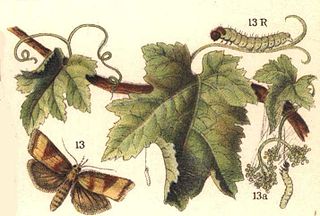
The Sparganothini are a tribe of tortrix moths.

The Archipini are a tribe of tortrix moths. Since many genera of these are not yet assigned to tribes, the genus list presented here is provisional.

Chlidanotinae is a subfamily of moths in the family Tortricidae.

The Cochylini are a tribe of tortrix moths. It used to be classified as the subfamily Cochylinae.
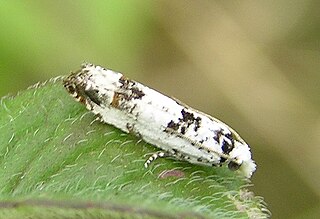
Eucosma is a very large genus of moths belonging to the family Tortricidae. Some taxonomies place a number of species in the genus Eucopina. The genus has a Holarctic and Indomalayan distribution. Even in well-studied Europe and North America, new species are still regularly discovered. There are at least 670 described species in Eucosma worldwide.

Eupoecilia ambiguella, the vine moth or European grape berry moth, is a Palearctic moth species of the family Tortricidae. It was first described in 1796 by Jacob Hübner. It is an economically significant grape pest species.

Cydia succedana, or Gorse Pod Moth is a species of moth of the family Tortricidae. It is found in Europe and has been introduced to New Zealand.

Mictocommosis is a genus of tortricid moths in the family Tortricidae. There are about six described species in Mictocommosis.
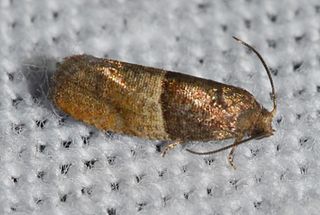
Larisa is a genus of moths belonging to the subfamily Olethreutinae of the family Tortricidae. It contains only one species, Larisa subsolana, which is found in North America, where it has been recorded from Alabama, Florida, Georgia, Illinois, Indiana, Kentucky, Maine, Maryland, Massachusetts, Minnesota, Mississippi, Missouri, New York, Ohio, Oklahoma, Ontario, Quebec, South Carolina, Tennessee, Texas, Virginia, and West Virginia.
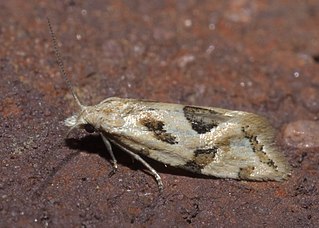
Aethes is a genus of moths belonging to the subfamily Tortricinae of the family Tortricidae.

The Euliini are a tribe of tortrix moths.

Aethes smeathmanniana, or Smeathmann's aethes moth, is a moth of the family Tortricidae. It was described by Johan Christian Fabricius in 1781. It is found in most of Europe, Asia Minor and in North America, where it has been recorded from New Jersey and Newfoundland and Labrador.

Aethes tesserana is a moth of the family Tortricidae. It is found in most of Europe, the Near East and northern Iran.
Mictocommosis godmani is a species of moth of the family Tortricidae. It is found in Tabasco, Mexico.
Mictocommosis argus is a species of moth of the family Tortricidae. It is found in Cameroon, Republic of Congo, Democratic Republic of Congo, Equatorial Guinea and Gabon.

Mictocommosis nigromaculata is a species of moth of the family Tortricidae. It is found in Japan, as well as Vietnam and Taiwan.
Mictocommosis stemmatias is a species of moth of the family Tortricidae. It is found on Sulawesi, an island in Indonesia.
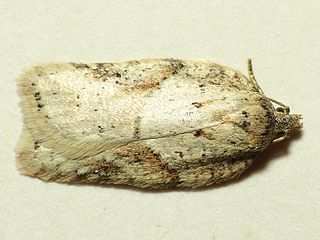
Acleris logiana, the black-headed birch leaffolder moth or grey birch button, is a moth of the family Tortricidae. It was described by Carl Alexander Clerck in 1759. It is found in most of Europe, except Ireland, Portugal, most of the Balkan Peninsula and Ukraine. It is also found in North America, the Russian Far East, Korea and Japan.
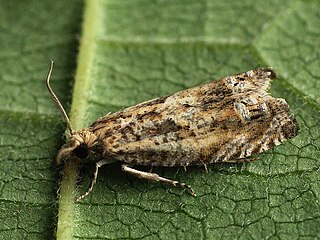
Eucosma aemulana, the obscure bell, is a species of moth of the family Tortricidae. It is found in China, Korea, Russia and most of Europe. It is also found in the United States, where it has been recorded from Colorado, New Mexico, Oklahoma and Utah. The habitat consists of woodlands, chalk downland and cliffs.















